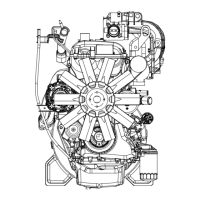DSG-423 CHARGING SYSTEM
06-5
DIAGNOSIS AND TESTING
WARNING: REFER TO CAUTIONS & WARNINGS AT
THE BEGINNING OF THIS SECTION.
NOTE: When the battery is disconnected and
connected, some abnormal symptoms may occur while
the GCP relearns its adaptive strategy. The engine may
need to run to relearn its strategy.
Preliminary Checks
Before beginning test procedures, check battery cables
and generator wiring (especially grounds) for clean,
tight connections. Wires and connectors should not be
damaged or corroded.
Perform the following checks before any testing:
• Loose or corroded connections at battery, grounded
starter motor cutout relay or engine.
• Inspect all connectors for loose or damaged pins,
wires, etc.
• Make sure the batteries are at 75% state of charge
(SOC) or higher. This represents an open circuit
voltage (OCV) of 12.4 volts. Batteries with an OCV
of 12 volts or less are either completely discharged
or have a dead cell.
• Check the generator drive belt tension. This will
cause low generator output.
• Check any light or indicator lamp filaments that are
suspected of being open (burned out). This is done
to avoid unnecessary extensive circuit checks.
• If a fuse is blown, locate the cause of the overload
condition and repair it. The common procedure is as
follows: isolate sections of the circuit, by
disconnecting connectors, and measure the
resistance to ground to find the circuit that is shorted
to ground. Then locate the damaged spot in the wire
or connector and repair.
• Excessive battery drain due to lamps left on,
damaged or misadjusted switch, accessories left on,
etc.
Warning Indicator Check
Check the operation of the charging system warning
indicator as follows:
• Ignition OFF = Indicator should be OFF.
• Ignition ON, Engine OFF = Indicator should be ON.
• Ignition ON, Engine ON = Indicator should be OFF.

